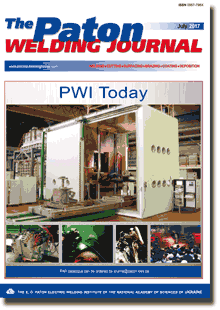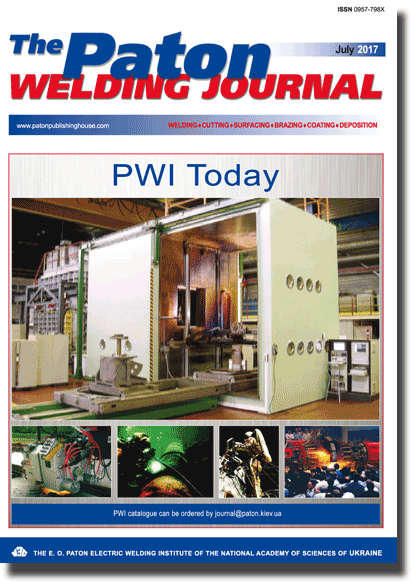| 2017 №07 (03) |
DOI of Article 10.15407/tpwj2017.07.04 |
2017 №07 (05) |

The Paton Welding Journal, 2017, #7, 19-22 pages
Investigation of microplastic deformation of metal deposited by electric resistance method
E.V. Berezhnaya1, V.D. Kuznetsov1, V.D. Kassov2 and P.A. Gavrish2
1NTTU Igor Sikorsky Kyiv Polytechnic Institute 37 Pobedy Ave., 03056, Kiev, Ukaine. Е-mail: elena.kassova07@gmail.com
2Donbass State Machine-Building Academy 72 Akademicheskaya Str., 84313, Donetsk region, Kramatorsk, Ukraine
Abstract
The search for optimization of structure and properties of the deposited metal of parts is an urgent task, the solution of which allows increasing their service properties and extending the service life. The data of investigations in this direction using the electric resistance surfacing are very limited. It was found in the work that the tendency of the deposited surface layer of a part (deposited metal and HAZ) to microplastic deformation is an important factor in determination of metal sensitivity to stress concentration. A structure of the deposited metal was obtained, which is characterized by a low sensitivity to stress concentration. It was shown that increase in the content of cementite in the structure of deposited layer leads to growth in tendency of accumulating dislocations during microdeformations, and the presence of a large volume of free ferrite allows decreasing the intensity of accumulating dislocations, reducing sensitivity of the deposited metal to stress concentration. 11 Ref., 2 Tables, 5 Figures.
Keywords: electric resistance surfacing, surface layer structure, microdeformation, stress concentration
Received: 13.09.17
Published: 01.09.17
References
- Burak, P.I. (2007) Driving forces of cohesion and formation of surface bonding process in electric resistance welding-on. Techn. and Economic J., 4(4), 33–37.
- Sajfullin, R.N. (2008) Restoration of machine parts by electric resistance welding-on of metal-powder compositions. Tekhnika v Selskom Khozyajstve, 2, 26–28.
- Sajfullin, R.N. (2009) Restoration of parts by electric resistance welding-on with flux-cored wire. Mekhanizatsiya i Elektrifikatsiya Selskogo Khozyajstva, 1, 27–28.
- Pontileenko, F.I., Lyalyakin, V.P., Ivanov, V.P. et al. (2003) Restoration of machine parts: Refer. Book. Moscow: Mashinostroenie.
- Chernoivanov, V.I., Lyalyakin, V.P. (2003) Organizing and technology of restoration of parts. Moscow: GOSNITI.
- Golovin, S.A., Pushkar, A. (1980) Microplasticity and fatigue of metals. Moscow: Metallurgiya.
- Madyanov, S.A., Kalinin, V.R., Kraev, A.P. et al. (1990) Examination of microplastic deformation as a method of evaluation of metal embrittlement. In: Mechanics and physics of fracture of brittle materials: Transact. Kiev, 33–38.
- Isaev, N.V. Shumilin, S.E., Zabrodin, P.A. et al. (2013) Strain hardening and stepwise deformation of ultrafine-grained polycrystals of solid solution Al–Li at temperature of 0.5 K. Fizika Nizkikh Temperatur, 39(7), 818–826.
- Markashova, L.I., Alekseenko, T.A., Zhdanov, S.L. et al. (2013) Influence of external static loading on change of metal structure parameters of over-heat area in HAZ of high-strength steel welded joints. Visnyk Chernigiv. Derzh. Tekhnol. Un-tu, 63(1), 87–92.
- Terentiev, V.F. (2006) Fatigue of high-strength steels. Part 1: Correlation with ultimate strength, types of curves and crack initiation. Deformatsiya i Razrusheniya Materialov, 8, 2–11.
- Chapetti, M.D., Tagawa, T., Miyata T. (2003) Ultra-long cycle fatigue of high-strength carbon steels. Part 1: Revive and analysis of the mechanism of failure. Sci. & Engin. A, 356(1/2), 227–235. https://doi.org/10.1016/S0921-5093(03)00135-7
Suggested Citation
E.V. Berezhnaya1, V.D. Kuznetsov1, V.D. Kassov2 and P.A. Gavrish (2017) Investigation of microplastic deformation of metal deposited by electric resistance method. The Paton Welding J., 07, 19-22.The cost of subscription/purchase order journals or individual articles
| Journal/Currency | Annual Set | 1 issue printed |
1 issue |
one article |
| TPWJ/USD | 384 $ | 32 $ | 26 $ | 13 $ |
| TPWJ/EUR | 348 € | 29 € | 24 € | 12 € |
| TPWJ/UAH | 7200 UAH | 600 UAH | 600 UAH | 280 UAH |
| AS/UAH | 1800 UAH | 300 UAH | 300 UAH | 150 UAH |
| AS/USD | 192 $ | 32 $ | 26 $ | 13 $ |
| AS/EUR | 180 € | 30 € | 25 € | 12 € |
| SEM/UAH | 1200 UAH | 300 UAH | 300 UAH | 150 UAH |
| SEM/USD | 128 $ | 32 $ | 26 $ | 13 $ |
| SEM/EUR | 120 € | 30 € | 25 € | 12 € |
| TDNK/UAH | 1200 UAH | 300 UAH | 300 UAH | 150 UAH |
| TDNK/USD | 128 $ | 32 $ | 26 $ | 13 $ |
| TDNK/EUR | 120 € | 30 € | 25 € | 15 € |
AS = «Automatic Welding» - 6 issues per year;
TPWJ = «PATON WELDING JOURNAL» - 12 issues per year;
SEM = «Electrometallurgy Today» - 4 issues per year;
TDNK = «Technical Diagnostics and Non-Destructive Testing» - 4 issues per year.


